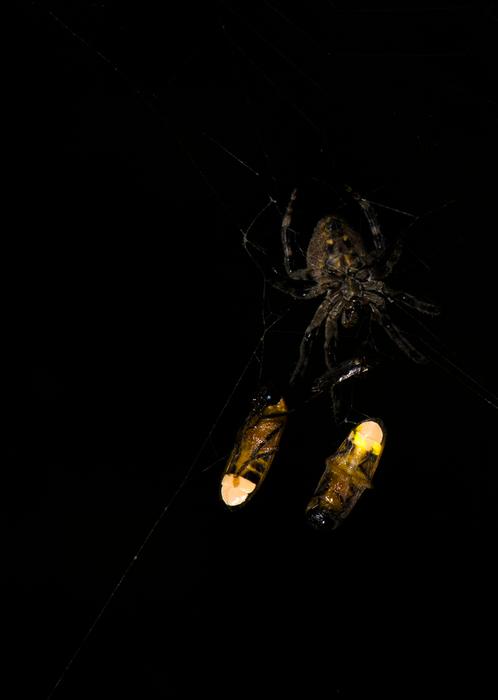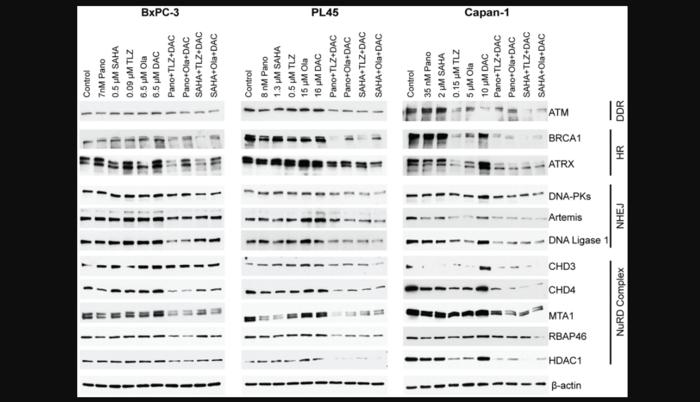Fireflies rely on flashing signals to communicate to other fireflies using light-emitting lanterns on their abdomens. In fireflies of the species Abscondita terminalis, males make multi-pulse flashes with two lanterns to attract females, while females make single-pulse flashes with their one lantern to attract males. Now researchers reporting in the journal Current Biology on August 19 have evidence that an orb-weaving spider (Araneus ventricosus) manipulates the flashing signals of male fireflies ensnared in its web such that they mimic the typical flashes of a female firefly, thereby luring other males to serve as their next meal.
Fireflies rely on flashing signals to communicate to other fireflies using light-emitting lanterns on their abdomens. In fireflies of the species Abscondita terminalis, males make multi-pulse flashes with two lanterns to attract females, while females make single-pulse flashes with their one lantern to attract males. Now researchers reporting in the journal Current Biology on August 19 have evidence that an orb-weaving spider (Araneus ventricosus) manipulates the flashing signals of male fireflies ensnared in its web such that they mimic the typical flashes of a female firefly, thereby luring other males to serve as their next meal.
“Drawing from extensive field observations, we propose that Araneus ventricosus practices deceptive interspecific communication by first ensnaring firefly males in its web and then predisposing the entrapped male fireflies to broadcast bioluminescent signals that deviate from female-attracting signals typically made by A. terminalis males and instead mimic the male-attracting signals typically made by females,” the researchers wrote. “The outcome is that the entrapped male fireflies broadcast false
signals that lure more male fireflies into the web.”
The discovery came after the first author of the new study, Xinhua Fu, from Huazhong Agricultural University, China, noticed several male fireflies ensnared in the webs of orb-weaving spiders while in the field. Strangely, he rarely, if ever, saw a female firefly in a web. Subsequent trips also revealed a similarly skewed pattern.
This led Fu to suspect that the spiders might be attracting males to their webs by somehow manipulating their flashing behavior. To test this hypothesis, behavioral ecologists Daiqin Li and Shichang Zhang from Hubei University, along with Fu, conducted field experiments that allowed them to observe both the spider’s behavior and the fireflies’ signals. Their studies showed that the spider’s web more often captured male fireflies when the spider was present in comparison to when the spider was absent from the web.
With further analysis, they found that the signals made by male fireflies in webs with spiders looked a lot more like the signals of free females. More specifically, the ensnared males used single-pulse signals using only one of their lanterns, not both. These ensnared male fireflies rarely lured other males when they were alone in the web.
The findings suggested that the males weren’t altering their flashes as a distress signal. The researchers propose that the spiders alter the firefly’s signal.
“While the eyes of orb-web spiders typically support limited spatial acuity, they rely more on temporal acuity rather than spatial acuity for discriminating flash signals,” Li said. “Upon detecting the bioluminescent signals of ensnared male fireflies, the spider deploys a specialized prey-handling procedure involving repeated wrap-bite attacks.”
The findings show that animals can use indirect yet dynamic signaling to target an exceptionally specific category of prey in nature. The researchers further suggest there may be many more undescribed examples in nature yet to be found in which predators may use mimicry to manipulate the behavior of their prey, based on communicative signals that may include sound, pheromones, or other means. They note that more study is needed to find out if the spider’s venom or the bite itself leads to changes in the ensnared males’ flashing pattern.
###
This work was supported by the National Natural Science Foundation of China, the National Key R&D Program of China, the Singapore Ministry of Education Academic Research Fund, and the Slovenian Research and Innovation Agency.
Current Biology, Fu et al. “Spiders manipulate and exploit bioluminescent signals of male fireflies” https://cell.com/current-biology/fulltext/S0960-9822(24)00914-X
Current Biology (@CurrentBiology), published by Cell Press, is a bimonthly journal that features papers across all areas of biology. Current Biology strives to foster communication across fields of biology, both by publishing important findings of general interest and through highly accessible front matter for non-specialists. Visit http://www.cell.com/current-biology. To receive Cell Press media alerts, contact [email protected].
Journal
Current Biology
DOI
10.1016/j.cub.2024.07.011
Method of Research
Experimental study
Subject of Research
Animals
Article Title
Spiders manipulate and exploit bioluminescent signals of male fireflies
Article Publication Date
19-Aug-2024






